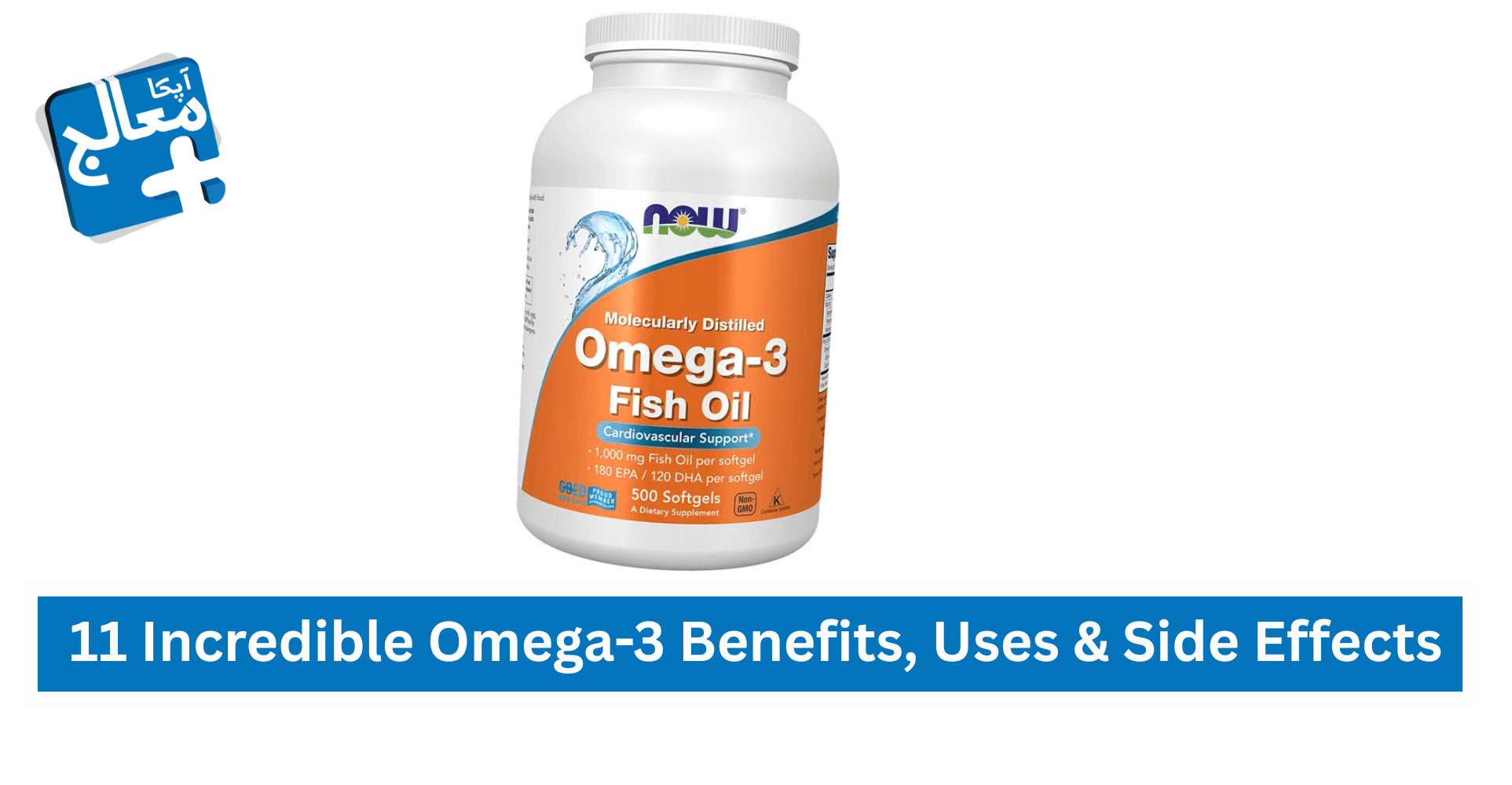11 Incredible Omega-3 Benefits, Uses, Side Effects & Best Sources

Fatty acids are the building blocks of fats in our body and food. Fatty acids provide energy, are important for growth, and support many body functions. According to the body's needs, there are two types of fatty acids. Non-essential fatty acids are those that the body can make from other nutrients, like palmitic acid, oleic acid, etc. While essential fatty acids are those that the body cannot make, so we must get them from food like Omega-3, Omega-6, etc.
Today, we will learn about the benefits of Omega-3 in this blog.
Also read: "Calosis-D Tablet: Benefits, Uses, Side Effects & Dosage"
What is Omega-3?
Omega-3 fatty acids are essential fats. They are crucial for overall health, supporting the heart, brain, and immune system. Found in fatty fish, seeds, and nuts, omega-3s have become a staple in health-conscious diets.
Types of Omega-3:
-
ALA (Alpha-Linolenic Acid): Found in plant oils like flaxseed, chia seeds, and walnuts.
-
EPA (Eicosapentaenoic Acid): Found mainly in fatty fish (salmon, mackerel, sardines).
-
DHA (Docosahexaenoic Acid): Found in fish, seafood, and algae; important for brain and eye health.
It is mentioned by the Harvard T.H. Chan School of Public Health,
"Omega-3 fatty acids play a crucial role in reducing inflammation and supporting cardiovascular health."
Benefits of omega-3
1. Supports Heart Health
-
Components: The EPA and DHA in Omega-3 play a key role in maintaining heart health.
-
Low Omega-3 Level: Increases risk of heart disease, high cholesterol, and high blood pressure.
-
Benefits: Omega-3 lowers triglyceride levels and helps maintain healthy cholesterol.
It reduces blood clotting and prevents plaque buildup in arteries.
It also lowers blood pressure, reducing the overall risk of heart disease.
2. Boosts Brain Function
-
Components: DHA, a major Omega-3 fatty acid, is vital for proper brain growth and function.
-
Low Omega-3 Level: May cause poor memory, learning issues, and cognitive decline.
-
Benefits: DHA is a key structural fat in brain cells, supporting memory and learning.
It improves communication between nerve cells, enhancing cognitive performance.
Omega-3 also helps reduce mental decline and supports emotional well-being.
3. Reduces Inflammation
-
Components: EPA from Omega-3 acts as a natural anti-inflammatory compound.
-
Low Omega-3 Level: It leads to more inflammation and worsens conditions like arthritis.
-
Benefits: EPA produces anti-inflammatory molecules called resolvins and protectins.
These molecules block inflammatory pathways in the body.
As a result, omega-3 helps ease conditions like arthritis and chronic inflammation.
4. Eye Health
-
Components: DHA found in Omega-3 is essential for protecting vision and eye health.
-
Low Omega-3 Level: It increases the risk of dry eyes and vision problems.
-
Benefits: DHA is a major structural component of the retina, supporting clear vision.
It helps prevent age-related macular degeneration and dry eye syndrome.
By protecting retinal cells, omega-3 maintains long-term eye health.
5. Supports Mental Health
-
Components: The combined action of EPA and DHA helps stabilize mood and support mental wellness.
-
Low Omega-3 Level: It may contribute to depression, anxiety, and mood swings.
-
Benefits: EPA helps regulate mood by reducing inflammation in the brain.
DHA maintains healthy brain cell membranes and improves communication between neurons.
Together, they may reduce symptoms of depression, anxiety, and other mood disorders.
6. Healthy Pregnancy
-
Components: DHA present in Omega-3 is important for a healthy pregnancy and fetal development.
-
Low Omega-3 Level: It can affect a baby’s brain and eye development, and raise the risk of preterm birth.
-
Benefits: DHA supports the baby’s brain and eye development during pregnancy.
It reduces the risk of premature birth and promotes healthy birth weight.
Omega-3 also supports the mother’s mood and overall well-being.
7. Weight Management
-
Components: Omega-3s EPA and DHA improve metabolism and assist in weight control.
-
Low Omega-3 Level: It may slow metabolism and increase fat storage.
-
Benefits: They improve metabolism, helping the body burn fat more efficiently.
Omega-3 reduces inflammation, which can improve insulin sensitivity.
It also increases feelings of fullness, helping control appetite.
8. Strengthens Bones
-
Components: By improving calcium balance, EPA and DHA in Omega-3 strengthen bones and joints.
-
Low Omega-3 Level: It can weaken bones and worsen joint pain.
-
Benefits: They improve calcium absorption, keeping bones strong and healthy.
Omega-3 reduces joint inflammation and stiffness in arthritis.
It helps maintain bone density, lowering the risk of osteoporosis.
9. Improves Sleep Quality
-
Components: DHA from Omega-3 supports melatonin production, improving sleep patterns.
-
Low Omega-3 Level: It may lead to poor sleep quality and insomnia.
-
Benefits: DHA supports the production of melatonin, the sleep hormone.
It helps regulate the sleep–wake cycle, leading to better rest.
Omega-3 reduces anxiety and stress, which can disturb sleep.
10. Supports Liver Health
-
Components: EPA and DHA in Omega-3 protect against liver diseases.
-
Low Omega-3 Level: It increases fat buildup, raising the risk of fatty liver disease.
-
Benefits: They reduce fat buildup in the liver, lowering the risk of fatty liver disease.
Omega-3 improves liver enzyme levels and overall function.
It also decreases inflammation, protecting the liver from long-term damage.
11. Enhances Skin Health
-
Components: Omega-3 fatty acids, EPA and DHA, nourish the skin, keeping it youthful and healthy.
-
Low Omega-3 Level: It can lead to poor sleep quality and insomnia.
-
Benefits: EPA helps regulate oil production, keeping skin hydrated and preventing acne.
DHA maintains skin cell membranes, improving softness and elasticity.
Together, they protect against sun damage and reduce signs of aging.
Also read: "What is Azithromycin? Usage, Side Effects & How to Manage It"
Side Effects of Omega-3
The use of omega-3 is generally safe, but if consumed in excessive amounts, it can be harmful.
|
Side Effect |
Description |
|
Fishy aftertaste or bad breath |
Unpleasant odor or taste after consuming Omega-3. |
|
Digestive discomfort in some individuals. |
|
|
Blood thinning (high doses) |
It can increase bleeding risk when taken excessively. |
|
Low blood pressure |
May cause drops in blood pressure in sensitive people. |
Best Sources of Omega-3

|
Category |
Examples |
|
Fatty Fish |
Salmon, mackerel, sardines, tuna |
|
Seeds |
Flaxseed, chia seeds, hemp seeds |
|
Nuts |
Walnuts, almonds |
|
Meats |
Grass-fed beef, lamb, chicken |
|
Vegetables |
Spinach, kale, Brussels sprouts, seaweed |
|
Fruits |
Berries (strawberries, blueberries), mangoes, papaya, avocado |
|
Cereals |
Oats, quinoa, fortified breakfast cereals |
|
Oils |
Flaxseed oil, canola oil, soybean oil |
|
Supplements |
Fish oil, krill oil, algal oil |
You may also read: "17 Powerful Surbex Z Benefits, Uses, and Side Effects"
Bottom Line
Omega-3 is very important for our overall health as it helps protect us from many diseases, since it plays a vital role in every organ of our body. When the human body receives everything in proper amounts, a person remains healthy.
As Dr. Michael Greger says:
"The science is clear: omega-3s are crucial for long-term health."
If you’d like to learn more about your daily nutritional intake and its impact on your overall health, consult with the best general physician or internal medicine specialist near you. For quick advice or to book an appointment, call 0423-2377001 and connect with a certified doctor through Apka Muaalij, Pakistan’s trusted telehealth platform.
Frequently Asked Questions (FAQs)
Can I get omega-3 from plants?
Yes, ALA is found in flaxseed, chia seeds, and walnuts.
How much fish should I eat weekly?
At least 2 servings of fatty fish per week.
Are omega-3 supplements safe?
Yes, but consult a doctor if on blood-thinning medications.
Can omega-3 improve mental health?
Yes, it may help reduce depression and anxiety symptoms.
Can children take omega-3 supplements?
Yes, with age-appropriate doses recommended by a pediatrician.
Is fish oil the same as Omega-3?
Fish oil is a source of Omega-3, mainly containing EPA and DHA.
How long does it take for Omega-3 to show benefits?
It may take 6–12 weeks of regular intake to notice improvements in health.

Dr. Bisma Shehzadi
Dr. Bisma Shehzadi, Pharm.D, RPh, is working as a professional seasoned content writer with 4 years of experience in healthcare and wellness writing. With a strong pharmaceutical background and clinical knowledge, she creates research-driven, search-optimized articles that simplify complex medical topics. Her writing enables her to craft content that educates, promotes wellness, and supports healthcare initiatives among online users and readers.
